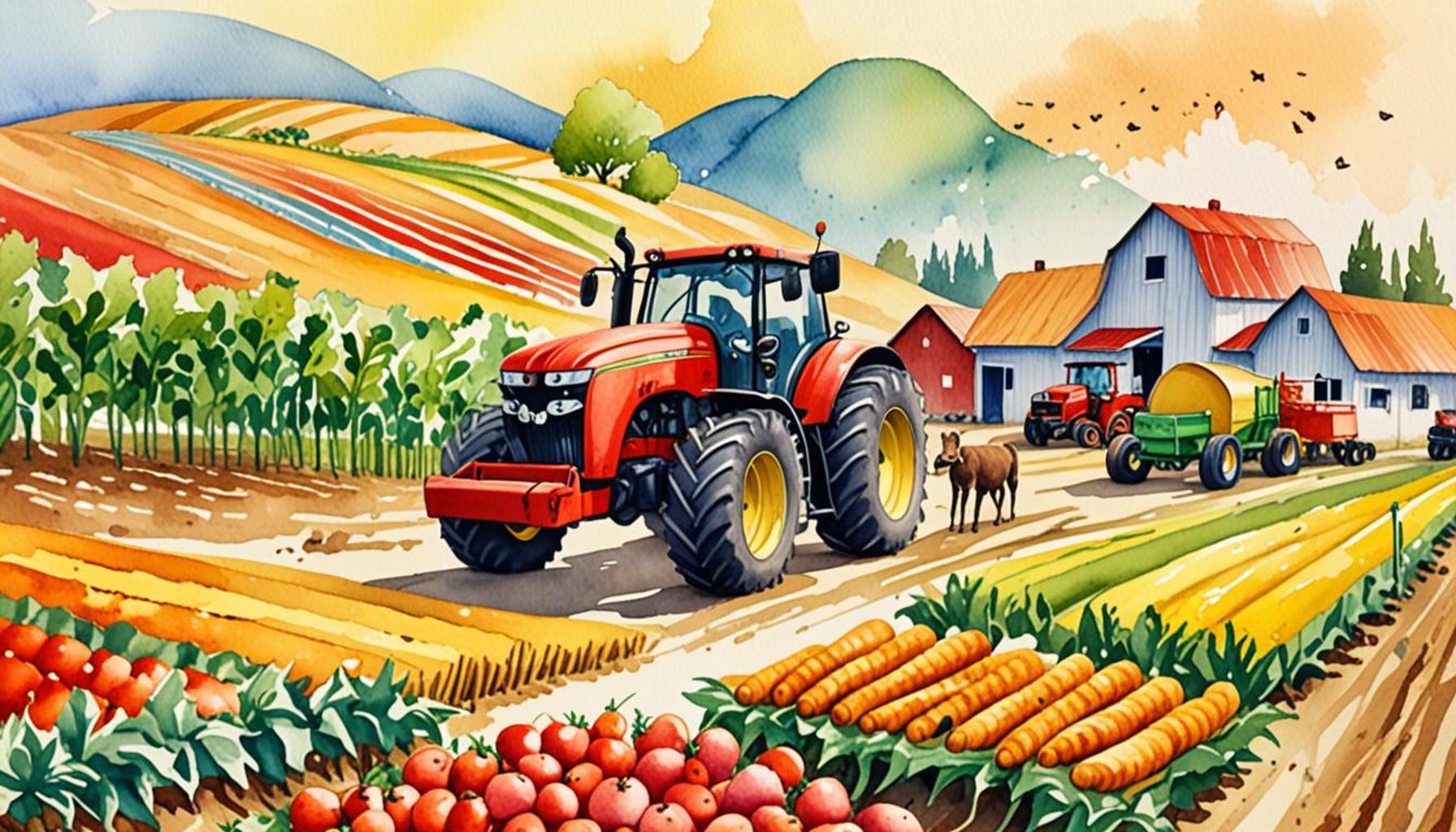Agricultural Subsidies and Their Implications for Food Security

Understanding Agricultural Subsidies
Agricultural subsidies are financial aids provided by governments to support farmers and stabilize food production. These subsidies can take various forms, including:
- Direct payments to farmers, which are cash payments designed to support income and mitigate risks associated with fluctuating market prices.
- Price supports, which ensure producers receive a minimum price for their crops, protecting them from market volatility.
- Tax breaks and exemptions, which reduce the financial burdens on farmers, allowing them to reinvest in their operations.
In the United States, these measures are crucial in shaping agricultural landscapes and ensuring the availability of food. The U.S. government allocates billions of dollars annually through various programs, impacting millions of farmers and the broader economy. However, the implications of such financial support extend beyond just economic relief; they intertwine with social, environmental, and health concerns.
Impact on Food Security
Food security is defined as the state where everyone has access to sufficient, safe, and nutritious food. Agricultural subsidies play a vital role in influencing this aspect by:
- Encouraging domestic production of essential crops such as corn, soybeans, and wheat, thus reducing dependency on imports and enhancing national self-sufficiency.
- Maintaining affordable prices for consumers, which can help lower the cost of staple foods and protect low-income families from market fluctuations.
- Affecting market competition, sometimes leading to innovations in farming techniques and environmentally sustainable practices, although this is not universally the case.
However, the relationship between subsidies and food security is complex. Critics argue that poorly designed subsidies can lead to:
- Overproduction of certain crops, such as corn, which can saturate the market and lead to price drops, destabilizing the income of farmers.
- Environmental degradation, as intensive farming practices encouraged by subsidies may deplete soil health and increase pesticide use, causing long-term ecological damage.
- Imbalanced food systems, where resources are disproportionately directed towards monoculture farming, undermining biodiversity and the resilience of the food system.
As we delve deeper into this topic, understanding the nuances behind agricultural subsidies will unveil their significant impact on our food systems and security. Given the ongoing debates and evolving agricultural policies, it is essential for stakeholders—ranging from farmers and consumers to policymakers—to engage in discourse about how these subsidies can be designed to achieve a more equitable and sustainable food future.
Ultimately, with food systems facing challenges such as climate change and population growth, examining agricultural subsidies’ role in enhancing, or undermining food security is not just timely; it is critical for ensuring that everyone has access to the nutrition they need to thrive.
RECOMMENDED: Check out this similar article
The Dual Edge of Agricultural Subsidies
Agricultural subsidies, while designed to bolster food production and support farmers, present a dual edge that can create both opportunities and challenges for food security in the United States. At the heart of the debate surrounding these subsidies lies the question of efficacy: are they genuinely fostering a stable and resilient food system, or are they contributing to long-term vulnerabilities?
To better understand the impact of agricultural subsidies on food security, one must examine their role in shaping agricultural practices, market dynamics, and consumer behavior. Subsidies not only affect what and how much is produced, but they also influence the prices consumers pay at the grocery store. In many cases, subsidies encourage farmers to focus on a limited number of high-yield crops, which can result in:
- Dependence on monoculture, favoring the cultivation of crops like corn and soybeans while neglecting a diverse range of produce that could support food systems.
- Market distortion, where heavily subsidized crops drive down prices, making it challenging for farmers of less-privileged crops to compete effectively.
- Inflated specializations, leading many farmers to invest heavily in a single crop rather than diversifying their yields, thus increasing their risk exposure to fluctuating market demands and climate variability.
Furthermore, while subsidies may lower food prices in the short term, they do not always translate into nutritional security. The focus on staple crop production can lead to a detrimental effect on public health, as consumers may have limited access to a variety of nutritious foods. For example, the glut of cheaper corn may result in increased consumption of processed foods, often high in sugars and unhealthy fats, contributing to rising obesity and diet-related health issues.
The implications of agricultural subsidies extend into socioeconomic realms as well. Low-income households, which are especially sensitive to food prices, might benefit from lower costs associated with subsidized crops. However, this price relief is often overshadowed by a lack of dietary diversity and quality. In contrast, the production of fruits and vegetables—foods integral to a balanced diet—generally receives less financial support, leading to food deserts in many urban and rural areas.
Moreover, the environmental repercussions of these subsidy policies cannot be overlooked. The promotion of high-yield, chemically intensive farming practices can exacerbate issues such as soil erosion, water contamination, and loss of biodiversity. A recent study has highlighted that areas with substantial agricultural subsidies have also seen increased levels of pollution, further complicating the relationship between farming practices and long-term food security.
As we turn our attention to the intricate connection between agricultural subsidies and their broader implications for food security, it is clear that a multi-faceted approach is necessary. Policymakers, farmers, and consumers all play crucial roles in reshaping these subsidies towards a model that prioritizes a healthy, sustainable food system that benefits all stakeholders involved.
| Advantages of Agricultural Subsidies | Implications for Food Security |
|---|---|
| Economic Stability | Ensures a steady food supply and pricing, reducing volatility. |
| Encouragement of Sustainable Practices | Promotes responsible use of resources, helping maintain ecosystem integrity. |
| Support for Small Farmers | Increases local food production, enhancing community resilience. |
| Affordability of Food | Lower prices for consumers, improving access to essential food items. |
The role of agricultural subsidies cannot be overstated, as they hold the potential to address myriad challenges faced by food security systems globally. By fostering economic stability, these financial aids can create resilience against unpredictable market forces. Additionally, when subsidies encourage sustainable practices, they not only support current food supply chains but also safeguard future production by preserving vital ecosystems.Furthermore, a focus on assisting small farmers can significantly impact local economies and food availability, underscoring the importance of strong community ties in agricultural production. With affordability being a central issue in food access, subsidies play a crucial role in lowering consumer prices, making nutritious food options accessible to a broader population. By understanding the multifaceted implications of agricultural subsidies, stakeholders can better navigate the complexities of modern food systems.
RECOMMENDED: Check out this similar article
The Need for Reform in Agricultural Subsidies
As the landscape of agricultural subsidies continues to evolve, it becomes increasingly evident that reform is necessary to align these policies with the overarching goal of enhancing food security. The challenge lies in navigating a complex web of interests, from large agribusinesses benefiting from existing subsidy structures to small-scale farmers striving for economic viability. Addressing these issues is crucial to fostering a more equitable and sustainable food system.
One area ripe for reform is the allocation of subsidies towards sustainable practices. Currently, a significant portion of funds support methods that prioritize yield over ecological health. According to the USDA, around $20 billion is spent annually on agricultural subsidies, with a disproportionate amount directed towards a handful of crops. Shifting these subsidies to incentivize practices such as crop rotation, organic farming, and regenerative agriculture could produce multiple benefits, including improved soil health, reduced chemical dependency, and resilient ecosystems that support a diverse range of crops. New data reveals that organic farms, which prioritize sustainability, can yield comparable or even superior outputs to conventional methods under the right conditions, thereby reinforcing the argument for a balanced subsidy approach.
Moreover, addressing production diversity is paramount. The current subsidy model predominantly supports crops like corn and soybeans, leading to a lack of investment in fruits, vegetables, and legumes—essential components of a balanced diet. Research shows that only about 2% of federal subsidies are allocated to these healthier crops. This imbalance not only limits access to nutritious food for consumers but also perpetuates health disparities, particularly in lower-income communities. Increased funding for a wider variety of crops could mitigate these issues while promoting better dietary habits among the populace.
Another critical aspect of reform lies in enhancing food access and reducing food insecurity. Programs such as the Supplemental Nutrition Assistance Program (SNAP) are vital for low-income families; however, they often rely heavily on subsidized foods that may not contribute to balanced nutrition. By revising subsidy structures to emphasize food types that align with nutritional programs, policymakers could work towards a system that ensures healthy options are not only available but also affordable for all consumers. Studies indicate that every dollar spent on SNAP generates approximately $1.79 in economic activity, so investment in healthy foods supported by subsidies could also stimulate local economies.
Moreover, as climate change poses existential challenges to food systems, adapting agricultural subsidies to account for resilience becomes ever more critical. Recent reports project that extreme weather patterns and increased volatility in growing seasons will exacerbate food insecurity. To combat this, subsidy programs must incorporate climate-smart initiatives that support farmers in their transition to practices that mitigate the impact of climate change. For instance, providing financial incentives for farmers to invest in drought-resistant crops can enhance long-term food production stability during adverse conditions.
In conclusion, while agricultural subsidies play a significant role in shaping the nation’s food landscape, their current structure is not without flaws. A recalibration is necessary—one that champions sustainability, diversity, and access—to ensure that these incentives serve the greater goal of improving food security for all Americans. Continued dialogue among stakeholders, including policymakers, farmers, nutritionists, and the broader community, will be essential in crafting a robust agricultural subsidy framework that benefits both the economy and public health.
YOU MAY ALSO LIKE: Read read another article
Conclusion
In summary, the intricate relationship between Agricultural Subsidies and Food Security requires a re-evaluation of existing policies to ensure they promote a resilient and equitable food system. The current subsidy structure, heavily skewed towards certain high-yield crops, limits dietary diversity and exacerbates food insecurity among vulnerable populations. A shift towards subsidies that prioritize sustainable agricultural practices, greater crop variety, and accessibility to nutritious food is not only essential for the well-being of citizens but also vital for long-term environmental health.
As highlighted throughout this discussion, investments in sustainable practices not only enhance food production resilience but also stimulate local economies. It’s important to note that every dollar invested in effective nutrition programs can yield significant economic returns, thereby reinforcing the symbiotic relationship between health, agriculture, and economic stability. Furthermore, as we grapple with the realities of climate change, the adaptation of subsidy frameworks will be crucial in ensuring that our agricultural systems can withstand unpredictable climatic fluctuations and continue to provide adequate food supplies.
Ultimately, fostering a collaborative approach that includes policymakers, consumers, and farmers will lead to a more robust framework surrounding agricultural subsidies. By prioritizing food security and sustainable practices, the nation can aspire towards a future where healthy food is accessible to all, enhancing both public health and environmental resilience. These efforts can pave the way for a comprehensive rethinking of how agricultural subsidies are structured, aiming for an equitable system that can genuinely ensure food security across all communities.


